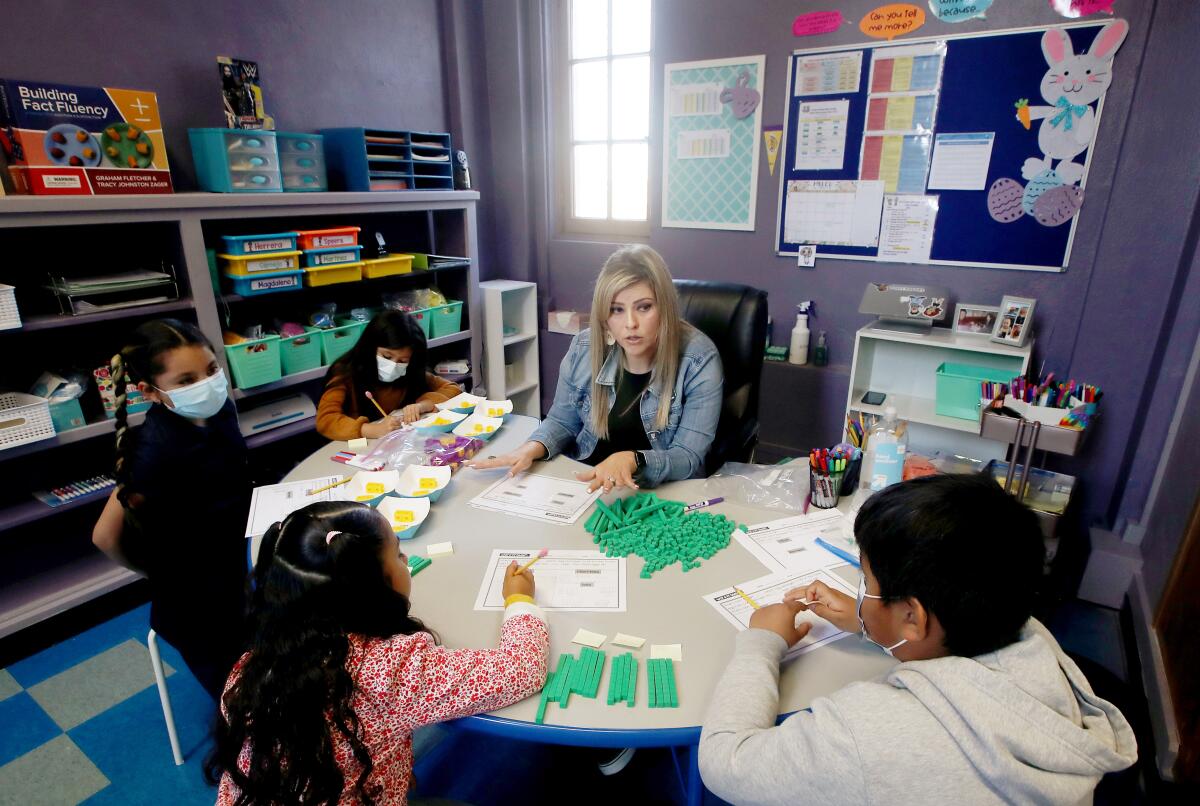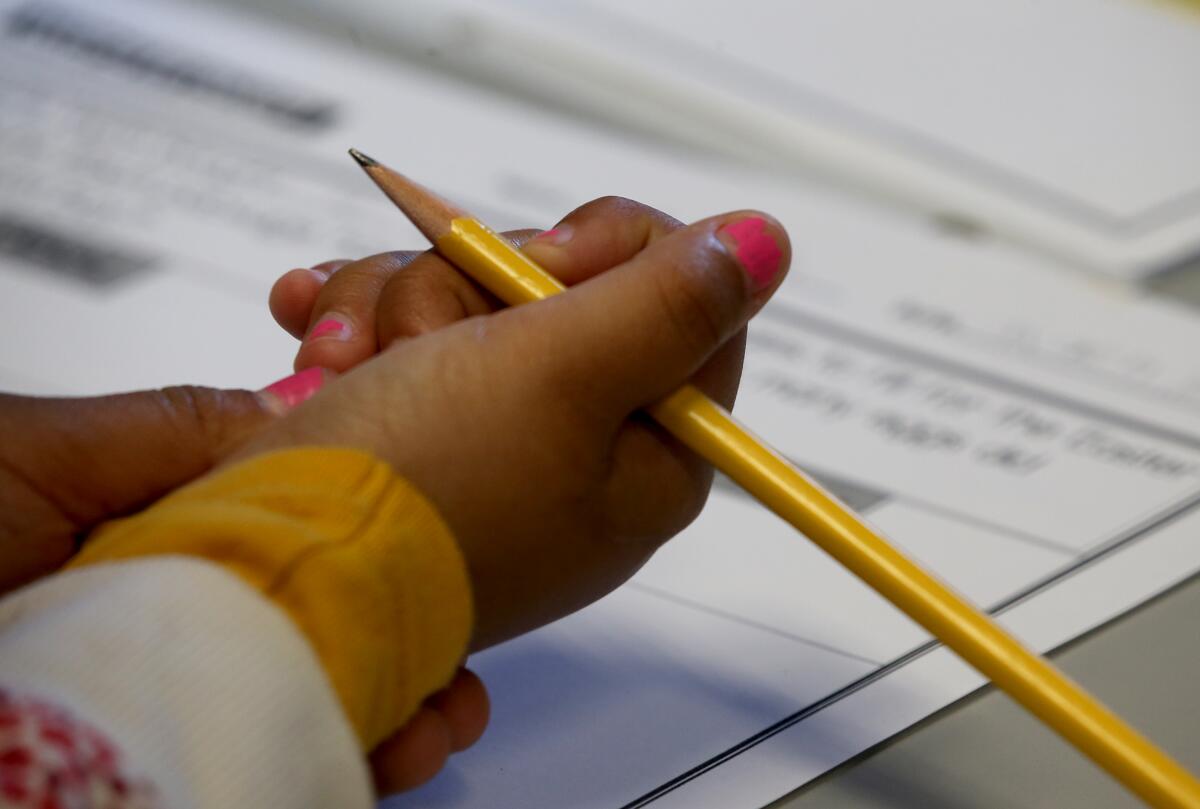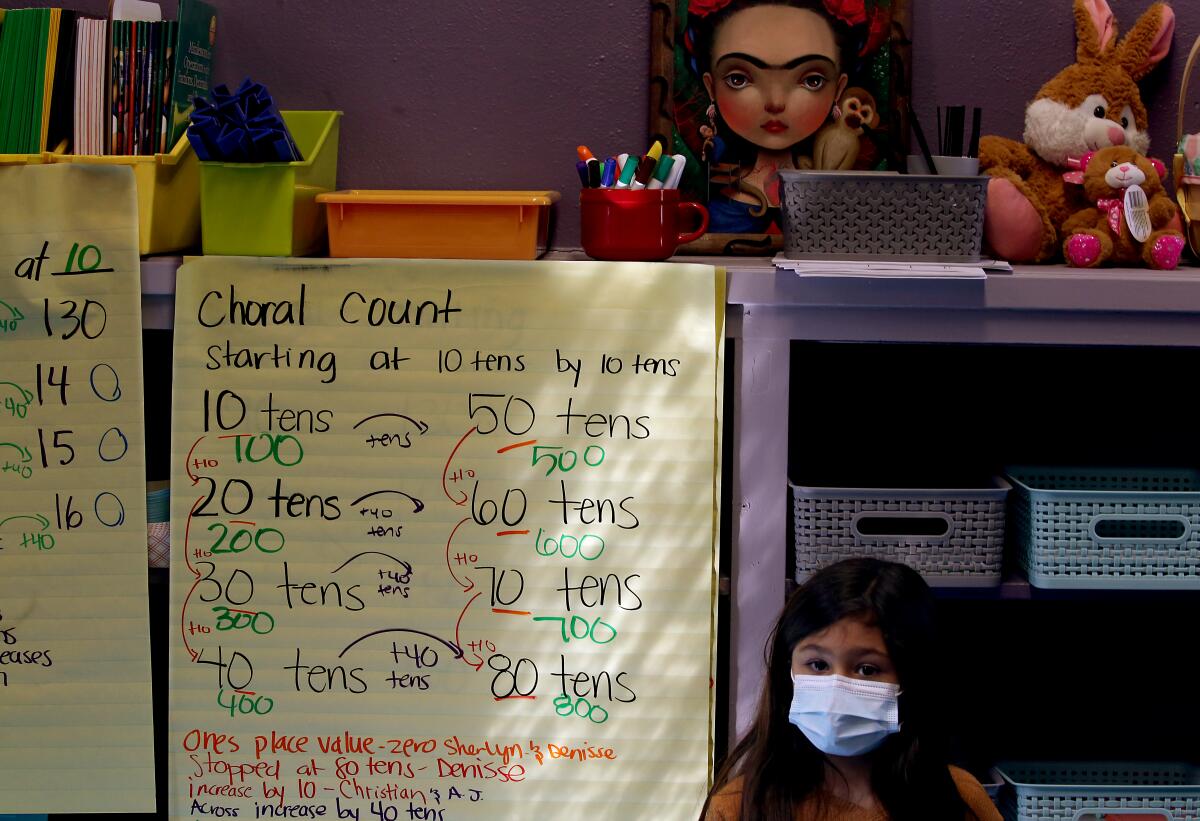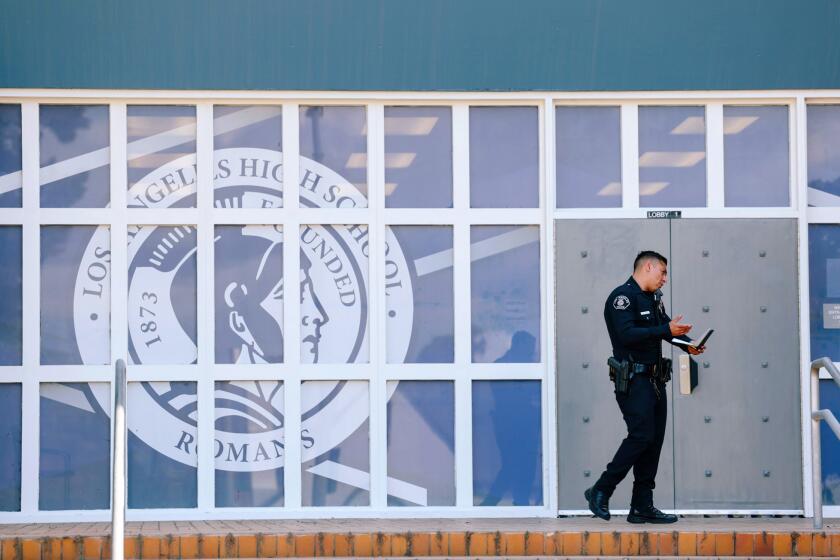LAUSD shakes up a highly praised academic initiative, angering parents and teachers

- Share via
A Los Angeles public school program that officials portrayed as a major success for helping struggling young students improve academically is being substantially dismantled by Supt. Alberto Carvalho, who says it’s too costly and not particularly effective.
The abrupt and unannounced change of direction to Primary Promise, which was launched in 2020, has angered many parents and teachers who viewed the effort as transformative in raising achievement in reading and math for students in kindergarten through third grade. Supporters are campaigning to save the program, which provided individually tailored reading and math instruction in small groups.
Using his authority as Los Angeles Unified superintendent, without a public discussion or action by the Board of Education, Carvalho has sharply reduced the budget for services provided by Primary Promise. The program served students at 305 of the district’s 450 elementary schools this year. Next year, the budget will cover 168 schools, according to preliminary numbers. Those remaining schools are considered to have the greatest need.
Carvalho — who did not make himself available for an interview — is moving forward with plans to instead add reading instructors at about two dozen middle schools and create jobs for about 200 coaches to help regular classroom instructors teach English learners more effectively.

The district did not provide budget information that would allow for a direct comparison between Primary Promise and the programs that are replacing it.
The district also has refused to release data justifying its move away from Primary Promise, which was a signature program of the previous LAUSD superintendent, Austin Beutner. A third-party evaluation, commissioned by the school system, is in progress.
The lack of transparency has added to the frustration of parents and teachers as efforts are underway to improve student performance after deep pandemic setbacks. Many don’t understand why a widely lauded effort is being upended for a new vision.
“Where are the school board conversations about it?” parent and teacher Nicolle Fefferman asked in a Facebook post. “It just feels like this program is being quietly killed without rhyme or reason.”
Whether year-round school or weeklong Thanksgiving break, school calendars provoke passion. Now there’s debate and pending legal action over the length of winter break.
In interviews, district officials defended the changes as part of a positive evolution.
“We’re in the process of continuing to improve what we had in place, learning from that and then moving beyond,” Deputy Supt. Karla Estrada said in an interview. “That’s just a good practice.”
District officials over the weekend provided a list they characterized as showing that 641 of 1,214 schools, including middle and high schools, will have some form of intervention next year. However, at least 136 of those schools turned out to be duplicates (mentioned more than once in various places on the list), raising new questions.
Change of message

During a public meeting in March 2022, district officials celebrated Primary Promise, presenting figures showing that struggling students who entered the program improved at a faster rate than students whose reading and math skills started off stronger.
While encouraging, the data were incomplete. For example, there was no comparison with past years to assess the extent to which students who are behind typically make greater gains because their regular classroom teachers concentrate on catching them up.
Still, many parents and teachers are convinced that the Primary Promise progress was real. The district’s original plan called for expanding the program to the remaining elementary schools — in a system where about 60% of students test below state standards in English-language arts, and about 70% test below state standards in math.
“This program has helped immensely, and I know it’s not just my kid,” said Danielle Watkins, who has twin third-graders at Charnock Road Elementary in Palms. “I was really upset to hear that they were getting rid of Primary Promise, knowing how much it benefited my son. I want others to have that kind of opportunity as well.”
Maria Nieto, a parent at Alta California Elementary School in Panorama City, also praised the program.
Supt. Alberto Carvalho wants to install outfacing perimeter cameras at schools to fend off crime, and has appealed to Mayor Karen Bass for speed bumps and flashing lights around campuses.
At the start of second grade, her daughter, who is learning English, “still was not proficient in reading but had trouble connecting the letter to the sound,” Nieto said in Spanish. “And she couldn’t add or subtract well, and she couldn’t read or write the numbers from one to 100.” Since then, her daughter has made strong progress, she said.
But Carvalho — who took charge of L.A. Unified in February 2022 after heading Miami-Dade Public Schools — had doubts. He soon concluded that Primary Promise was expensive and far from revolutionary, although he said it is one of many “best practices.”
“Primary Promise, when you really look at it, is a 2-inch-wide strategy that most effective districts utilize, which consists of empowering great educators who become interventionists,” Carvalho said in an August interview with The Times. “We had it in Miami. Most districts across the country have it. It was a repackaged idea.”
He faulted the district for moving top-notch classroom teachers into Primary Promise and replacing them, in some cases, with under-qualified substitutes who were assigned to regular classrooms for as long as a year.
“That is absolutely wrong,” he said in the earlier interview.
Under his revamped plan, no newly hired interventionists can begin until their former classroom is backfilled with a credentialed teacher, and the specialists in teaching English learners will focus primarily on training classroom teachers, rather than on working directly with students.
In a May 9 memo to the school board, Carvalho said the plan will “build off the lessons learned from Primary Promise” and pledged stronger, more affordable initiatives. The memo contained no budget information. Much of the memo consisted of listing teaching strategies for the new effort that already are part of Primary Promise.
In interviews, Estrada and Chief Academic Officer Frances Baez emphasized that training once reserved for Primary Promise teachers would now reach more regular classroom teachers. Also, the intervention staff at the remaining highest-needs schools would increase their emphasis on teaching writing skills.
Carvalho’s intervention plan will have a new name: Literacy and Numeracy Intervention Model.
How Primary Promise worked
Primary Promise has relied on extra staffing, continuous individualized instruction and regular assessments.
Selected students in kindergarten through third grade have received 30 to 60 minutes per day of tutoring in small groups with the same teacher and a full-time aide — both with specialized training in teaching either reading or math. To track progress, teachers gave assessments every two to three weeks — data evaluated by district coordinators.
Students remaining in the regular classroom also were left in a smaller group as they developed skills at their own level.
This has provided the sort of low student-teacher ratio that parents seek when sending their children to private schools — or when they hire private tutors.
“Why wouldn’t that work with low-income kids?” asked Pedro Noguera, dean of the USC Rossier School of Education. “It usually will. The challenge is doing it at scale — and ensuring that there’s a good match between the interventionist and the students.”
Primary Promise teachers have been spared yard duty and such tasks as having to cover for absent instructors. A typical caseload has been 30 to 45 students per teacher.
Students leave the program when they are caught up — and there’s never a shortage of students in need to replace them.
Primary Promise teacher Marci Edge cited the example of a second-grader who “has gone from 13 words per minute to 70 words per minute this year — so she’s gone from a nonreader to a reader.”
Many second-graders lost ground after spending kindergarten in front of a computer screen at home, in virtual learning, because the COVID-19 pandemic had closed campuses.
The child Edge referred to will need continued support “so she doesn’t slip back. And I can’t look the parent in the face and say, ‘Sorry, I won’t be here next year.’”
Edge won’t return to San Jose Elementary in Mission Hills. Her position there is no longer being centrally funded, although she was able to find similar work at another campus. District principals have the option of using funds they control to purchase an interventionist, but that has led to hard choices for schools with limited budgets.
In explaining the changes, school board President Jackie Goldberg said that principals could still purchase intervention services and that Primary Promise worked well in some places but not so well in others.
Board member Tanya Ortiz Franklin said she liked that older students would be receiving more reading intervention under the new plan.
A pricey best practice
Documents obtained by The Times indicate that Primary Promise was budgeted for about $40 million in the 2021-22 school year and $134 million this year and would have jumped sharply in future years as it spread to all elementary schools. The costs relate to staffing, a higher-than-typical teacher salary, training and materials.
Beutner’s 2020 strategy had been to try out Primary Promise; then, if it proved successful, to appeal to the state, taxpayers and donors for funding. But the pandemic increased the need for a broader program, and one-time pandemic aid has been used to expand it.
Beutner declined to comment on the changes to the program because he does not know its details. He said he continues to support the Primary Promise concept because it works. In an interview shortly after leaving L.A. Unified, Beutner said he’d intended to extend Primary Promise to all elementary schools — regardless of cost.
“The superintendent’s responsibility is much more in the here and now, to make sure children are being taught to read, and we’re doing a darn good job on that,” Beutner said in July 2021. “What the dollars look like two to three years down the road, we can have that conversation. ... I sure hope the state is planning for that.”
Teachers said they learned of the program’s abrupt cancellation in late February or March, with virtually no explanation. As word began to circulate, protesting voices increased.
Carvalho’s memo presented a starkly different conclusion about the results than had been proclaimed last year: “There is limited data supporting that the current approach has achieved the results as envisioned.”
But no data were released to accompany this verdict — exasperating teachers and families.
Defenders of Primary Promise accuse Carvalho of upending the program because it dates to his predecessor. They said money for the program could have been set aside in lieu of district efforts they believe have been less helpful, such as “acceleration days” — four optional days of school that took place over winter and spring breaks. The district has refused to provide a detailed breakdown of what those days cost, although officials had budgeted about $123 million for staffing, teacher training and other expenses.
During a May 16 board meeting, Carvalho seemed to be referring to efforts such as Primary Promise in remarks related to the overall budget.
“I get emails about decisions that were made about programs, expansions, investments, without ever really conveying to the community how those were being financed,” he said. “And those are to the tune of hundreds of millions of dollars that will disappear in two years. ... They are just not sustainable the way they were designed, developed and implemented.”
Times staff writer Paloma Esquivel contributed to this report.
More to Read
Sign up for Essential California
The most important California stories and recommendations in your inbox every morning.
You may occasionally receive promotional content from the Los Angeles Times.
















